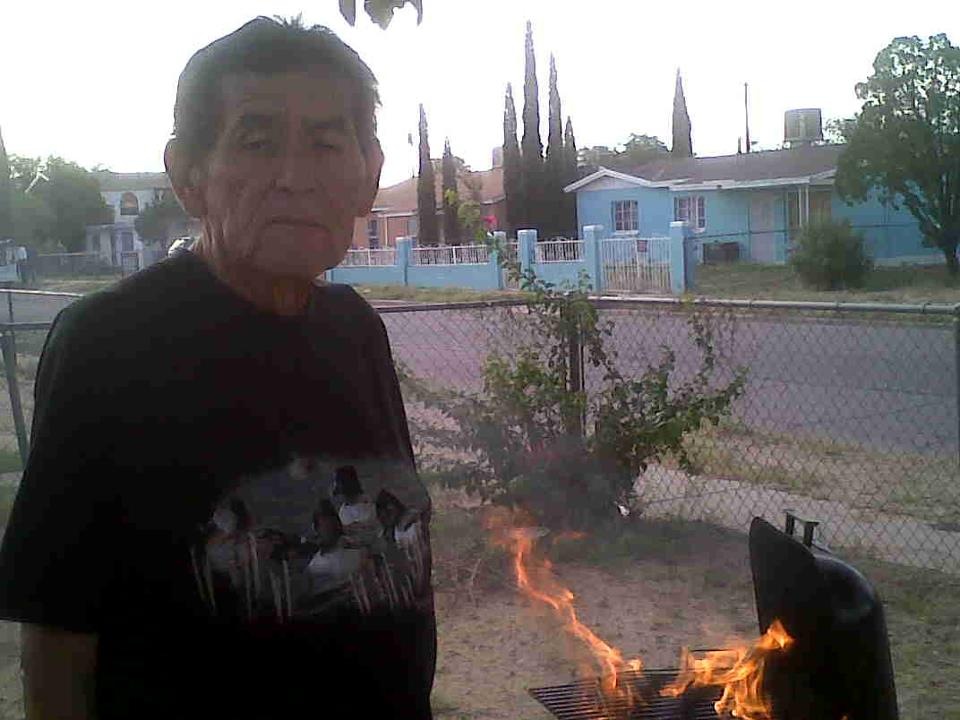
Felipe Martinez has to go to the hospital every week to have his blood drained to get clean new non-alcoholic blood in his system. (Courtesy of Felipe Martinez)
EL PASO – “I could say God has damned me, but I can only believe I have damned myself,” he paused looked around with miniscule eyes, holding back every tear trying to escape from his sorrowful eyes and whispered, “I’ve damned myself and my family till the day I die. It shouldn’t be long.”
For 34 years Felipe Martinez, now 56, has been suffering with an unbeatable addiction, alcoholism. Now struggling to save his own life because of cirrhosis, an irreversible result of various disorders that damage liver cells over time. Eventually, damage becomes so extensive that the normal structure of the liver is distorted and its function is impaired.
The liver damage requires him to go to the hospital every week to have his blood drained to get clean new non-alcoholic blood in his system. He hopes and prays he can share his story to warn others to learn from his mistakes. He begs to be heard. He’s been clean for four months. It’s his last option.
Alcohol is the most widely used and abused drug in America. According to the 2012 National Household Survey, 103 million people in the United States are current drinkers and 11 million are heavy drinkers.
The National Institutes of Health reports that 15 percent of the people living in the United States are considered “problem drinkers.” Of this 15 percent, 5 percent to 10 percent are males and 3 percent to 5 percent are females. Approximately 30 percent of people in the U.S. report experiencing an alcohol disorder at one point in their lifetime.
“Approximately 90% of alcoholics experience at least one relapse in the four years following treatment,” says Mike Roser, director for the University Behavior Health El Paso. “Similar relapse rates occur for recovering smokers and heroin addicts, suggesting that many addictive behaviors may share the same behavioral, biochemical, and cognitive components.”
“I’m just another man who made a lot of mistakes in his life. I know you have no reason to listen to me. No reason to hear out a desperate fool who chose his own destiny,” says Martinez.
A majority of society is able to drink alcohol responsibly. They will consume alcohol in social situations and continue on with their day to day life without their alcohol use causing damage to themselves or those around them. On the other hand, some people are not able to stop or control their alcohol use. For these individuals, what was once a social experience becomes a way of life.

Felipe Martinez before being diagnosed with cirrhosis. (Courtesy of Felipe Martinez)
“I couldn’t stop. Every day I saw how much this was affecting my family. Don’t get me wrong, I never swung a hit to my wife or my kids but simply having your 12-year-old daughter carry you to your bedroom is abuse in itself,” said Martinez.
Martinez lying on his hospital bed for the fourth time in the past two months seemed very regretful. His hand movements were slow, hardly there, either due to the lack of muscle and strength or the resentment and desperation of lying there once again.
“You know, I actually tried to stop many many years back. But I became dependent on the alcohol. If I had a bad day at work, there it was. If I fought with my wife even if it was because I was drinking, there it was. If I was simply thirsty, there it was. If I had a headache because I was drunk the night before, fell and hit my head, there it was.”
Researchers from the University of California in San Diego have found that the lifetime risk of alcohol-use disorders for men is greater than 20 percent. They share that there is a risk of around 15 percent for alcohol abuse and 10 percent risk for alcohol dependence.
Martinez said with a small chuckle that when he was dragged to the institution for alcohol abusers, and forced to stay there, he ran out. “I gave those nurses the hardest time, just so they can kick me out. I’m not proud of it but now thinking back, it was kind of funny the things I would do just to get out.”
Information from the World Health Organization shows that there are an estimated 140 million alcoholics around the world. Recently, a study conducted in Canada on alcoholism statistics showed that 1 in 25 deaths around the world can be attributed to alcohol in one way or another.
On a positive note, experts estimate that around 30 percent of people who have problems with alcohol (not severe alcoholics) are able to reduce their alcohol consumption or abstain completely from alcohol without receiving professional help.
While institutionalized, Martinez got very sick. He was taken to the hospital and the nurses, the family, and the doctors all thought it was just another frantic ploy to get out, but he really was sick. The doctor said that since he was so used to the alcohol in his system, his system became dependent on the alcohol too.
“I received the weirdest medication. He told me, ‘drink, because this far in the game, all you can do to survive is drink. Drink till your system runs out, and spoils, and rots.”
“He was right. My system has spoiled, rotted, flushed and drained.” He stopped laughing looked at me and said with irony in his weak narrow eyes, “Now I’m here every other week getting my blood full of alcohol drained, and receiving new blood.”
Alcoholism statistics from the National Institute on Alcohol Abuse and Alcoholism show that the age of a person’s first alcoholic drink may determine their likely hood in becoming an alcoholic. It has been found that those who had their first alcoholic drink before they were 15 were much more likely to have a problem with alcohol later in life than those who abstained until a later age.
When Martinez was told about this statistic he chuckled under his breath and said, “Would you look at that. I started sneaking in beer when I was 13.”


